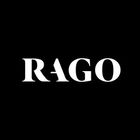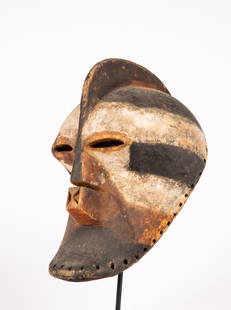
LUBA-SONGYE, KIFWEBE MASK, CONGO
Similar Sale History
View More Items in Masks
Related Masks
More Items in Masks
View MoreRecommended Art
View More













Item Details
Description
Early 20th c.
Carved wood
Without stand: 16 1/4" x 9 3/4"
Provenance: Armand Arman, New York
John Giltsoff, London
Allan Stone Collection, New York (acquired from the above in 1981)
Exhibition: Power Incarnate: Allan Stone's Collection of Sculpture from the Congo, Bruce Museum, May 14 - September 4, 2011, Greenwich, Connecticut
Literature: Dumouchelle, Kevin. Power Incarnate: Allan Stone's Collection of Sculpture from the Congo. Greenwich, CT: Bruce Museum, 2011, Illus p. 49
The striated face masks known as kifwebe likely originated in what is now the Shaba region of the Democratic Republic of Congo, southeast of the Congo River basin, an area inhabited by both Songye and Luba groups. For this reason, it is not unusual to see a masking tradition that seems to incorporate stylistic elements of both groups. This mask belongs to a small corpus of Luba-Songye masks generally known as being in the ‘Mussolini style’. It is characterized by a box-like projecting mouth, prominent semi-circular bulbous upper eyelids, the broad triangular nose, and large dominant forehead accentuated with a band extending from the nose across the top of the head. (According to Willy Mestach, among the Songye a man with such protuberant lips was regarded as a strong speaker.) The big eyes, in their turn, may refer to the use of a poisonous drug, which caused an intense swelling of the eyes. The facial surface of this mask is covered by thin, grooved linear incisions
the repetition of the striations evokes movement. About a dozen masks of the Mussolini workshop are known. Hierarchical and functional distinctions between female and male masks are reflected in color and in sculptural features. This is a female kifwebe mask, though the basic color is dark, which is the usual color of male masks. According to Alain Naoum, female masks (bifwebe bakashi) are known to have appeared on the occasion of a chiefÂ’s death or investiture and during lunar rites. They played an integral role in the symbolic composition of these rituals by animating life forces through dance, calling the benevolent spirits from the forest and beyond to bring descendants to the villagers. Women, as the bearers of children and therefore good fortune, perpetuated the lineage and simultaneously also the magical essence of buci. Thus the female masks represented the continuity of life and cultural tradition. As documented by anthropologists, the precise functions and roles of these masks have evolved over time, reflecting their complexities and importance within the society. The traditional political organization of the Songye rested on the authority of the chief. In consolidating and bolstering the strength of their rule, chiefs were assisted by two secret menÂ’s associations, one practicing witchcraft (buci) and sorcery (masende), and the other, bwadi bwa kifwebe. Bwadi bwa kifwebe was responsible for the performances of the kifwebe masks. Bwadi bwa kifwebe assured the well-being and continuity of the community by enforcing societal laws and appealing to benevolent spirits. This society possessed the power of political and social control, demanded contributions from spectators during its public appearances and could also lease its services to other associations (for example for initiation ceremonies). Since the masqueradersÂ’s disguise preserved the anonymity of specific individuals, suspicion of sorcery, which could not be channeled at particular persons of rank, was absorbed by the kifwebe creature. These masks, supplemented by a woven costume and a long beard of raffia bast were accompanied by singers and dancers. Although their forms, patterns, colors, and behaviors are inspired by and derived from human beings and animals, kifwebe were supports for supernatural beings.
References
Barbier-Mueller, Monique. African Faces, African Figures. The Arman Collection. New York: Museum of African Art, 1997, pl. 166 Hersak, Dunja. Songye Masks and Figure Sculpture. London: Ethnographica, 1995 Morigi, Paolo. Raccolta di un amatore d'arte Primitiva. Bern, Switzerland: Kunstmuseum, 1980: 355, pl. 310 Newton, Douglas. Masterpieces of Primitive Art: The Nelson A. Rockefeller Collection. New York: Alfred A. Knopf, 1978, p. 82. Rubin, William. Primitivism in 20th Century Art. Affinities of the Tribal and the Modern. New York: Museum of Modern Art, 1984, pl. 173 Songye peoples, Democratic Republic of the Congo, Africa, Collections, Metropolitan Museum of Art (metmuseum.org) Collection Comparables Cincinnati Art Museum, Songye mask (cincinnatiartmuseum.org id 16718977) University of Iowa, Songye mask (africa.uima.uiowa.edu) Yale Van Rijn Archive of African Art - Songye Kifwebe female mask ID number 0000300 (Alain Naoum) - Songye Kifwebe female mask ID number 0000301 (Alain Naoum) - Songye Kifwebe female mask ID number 0004982 (Dartevelle) - Songye Kifwebe female mask ID number 0004980 (ex Patric Claes, Peter Loebarth, Jacques Hautelet) See also Neyt, Francois. Arts Traditionelle Et Histoire Au Zaire. Societe D'Arts Primitifs, Institute Superieur D'Archeologie et D'Histoire D'Art Universite Catholique De Louvain, 1981
Roy, Christopher D. Art and Life in Africa. Selections from the Stanley Collection, 1992: 164-165, pl. 114 - Songye Kifwebe female mask ID number 0002792 (Watson). See also Fagaly, William A. Shapes of power, belief, and celebration: African art from New Orleans collections. New Orleans Museum of Art, 1989, Nicolas, Alain. Arman & l'art africain. Diffusion, Seuil, 1996, pl. 159
Carved wood
Without stand: 16 1/4" x 9 3/4"
Provenance: Armand Arman, New York
John Giltsoff, London
Allan Stone Collection, New York (acquired from the above in 1981)
Exhibition: Power Incarnate: Allan Stone's Collection of Sculpture from the Congo, Bruce Museum, May 14 - September 4, 2011, Greenwich, Connecticut
Literature: Dumouchelle, Kevin. Power Incarnate: Allan Stone's Collection of Sculpture from the Congo. Greenwich, CT: Bruce Museum, 2011, Illus p. 49
The striated face masks known as kifwebe likely originated in what is now the Shaba region of the Democratic Republic of Congo, southeast of the Congo River basin, an area inhabited by both Songye and Luba groups. For this reason, it is not unusual to see a masking tradition that seems to incorporate stylistic elements of both groups. This mask belongs to a small corpus of Luba-Songye masks generally known as being in the ‘Mussolini style’. It is characterized by a box-like projecting mouth, prominent semi-circular bulbous upper eyelids, the broad triangular nose, and large dominant forehead accentuated with a band extending from the nose across the top of the head. (According to Willy Mestach, among the Songye a man with such protuberant lips was regarded as a strong speaker.) The big eyes, in their turn, may refer to the use of a poisonous drug, which caused an intense swelling of the eyes. The facial surface of this mask is covered by thin, grooved linear incisions
the repetition of the striations evokes movement. About a dozen masks of the Mussolini workshop are known. Hierarchical and functional distinctions between female and male masks are reflected in color and in sculptural features. This is a female kifwebe mask, though the basic color is dark, which is the usual color of male masks. According to Alain Naoum, female masks (bifwebe bakashi) are known to have appeared on the occasion of a chiefÂ’s death or investiture and during lunar rites. They played an integral role in the symbolic composition of these rituals by animating life forces through dance, calling the benevolent spirits from the forest and beyond to bring descendants to the villagers. Women, as the bearers of children and therefore good fortune, perpetuated the lineage and simultaneously also the magical essence of buci. Thus the female masks represented the continuity of life and cultural tradition. As documented by anthropologists, the precise functions and roles of these masks have evolved over time, reflecting their complexities and importance within the society. The traditional political organization of the Songye rested on the authority of the chief. In consolidating and bolstering the strength of their rule, chiefs were assisted by two secret menÂ’s associations, one practicing witchcraft (buci) and sorcery (masende), and the other, bwadi bwa kifwebe. Bwadi bwa kifwebe was responsible for the performances of the kifwebe masks. Bwadi bwa kifwebe assured the well-being and continuity of the community by enforcing societal laws and appealing to benevolent spirits. This society possessed the power of political and social control, demanded contributions from spectators during its public appearances and could also lease its services to other associations (for example for initiation ceremonies). Since the masqueradersÂ’s disguise preserved the anonymity of specific individuals, suspicion of sorcery, which could not be channeled at particular persons of rank, was absorbed by the kifwebe creature. These masks, supplemented by a woven costume and a long beard of raffia bast were accompanied by singers and dancers. Although their forms, patterns, colors, and behaviors are inspired by and derived from human beings and animals, kifwebe were supports for supernatural beings.
References
Barbier-Mueller, Monique. African Faces, African Figures. The Arman Collection. New York: Museum of African Art, 1997, pl. 166 Hersak, Dunja. Songye Masks and Figure Sculpture. London: Ethnographica, 1995 Morigi, Paolo. Raccolta di un amatore d'arte Primitiva. Bern, Switzerland: Kunstmuseum, 1980: 355, pl. 310 Newton, Douglas. Masterpieces of Primitive Art: The Nelson A. Rockefeller Collection. New York: Alfred A. Knopf, 1978, p. 82. Rubin, William. Primitivism in 20th Century Art. Affinities of the Tribal and the Modern. New York: Museum of Modern Art, 1984, pl. 173 Songye peoples, Democratic Republic of the Congo, Africa, Collections, Metropolitan Museum of Art (metmuseum.org) Collection Comparables Cincinnati Art Museum, Songye mask (cincinnatiartmuseum.org id 16718977) University of Iowa, Songye mask (africa.uima.uiowa.edu) Yale Van Rijn Archive of African Art - Songye Kifwebe female mask ID number 0000300 (Alain Naoum) - Songye Kifwebe female mask ID number 0000301 (Alain Naoum) - Songye Kifwebe female mask ID number 0004982 (Dartevelle) - Songye Kifwebe female mask ID number 0004980 (ex Patric Claes, Peter Loebarth, Jacques Hautelet) See also Neyt, Francois. Arts Traditionelle Et Histoire Au Zaire. Societe D'Arts Primitifs, Institute Superieur D'Archeologie et D'Histoire D'Art Universite Catholique De Louvain, 1981
Roy, Christopher D. Art and Life in Africa. Selections from the Stanley Collection, 1992: 164-165, pl. 114 - Songye Kifwebe female mask ID number 0002792 (Watson). See also Fagaly, William A. Shapes of power, belief, and celebration: African art from New Orleans collections. New Orleans Museum of Art, 1989, Nicolas, Alain. Arman & l'art africain. Diffusion, Seuil, 1996, pl. 159
Condition
Condition is considered good with signs of wear indicating ceremonial use. There are various nicks and abrasions with minor surface loss. On the proper right lower edge of the masks there are losses that extend about 2 ¼”. There is some insect damage with loss along the upper proper left side of the mask. The back of the mask is heavily abraded through use as it contacted the forehead, mouth, and nose. There are twenty suspension holes located on the edge of the mask. Which demonstrate appropriate wear for a ceremonial mask of this type.
Condition reports are rendered as specialist opinion by the staff of the Auction House and/or independent consultants and not as statements of fact. We do not guarantee the content of written or verbal condition reports. The absence of a condition report does not imply that there are no condition issues with the lot. ?? ?Please call us at (609) 397-9374 or e-mail info@ragoarts.com with any questions about this lot at least 24 hours prior to auction.?
Buyer's Premium
- 30%
LUBA-SONGYE, KIFWEBE MASK, CONGO
Estimate $100,000 - $150,000
14 bidders are watching this item.
Shipping & Pickup Options
Item located in Lambertville, NJ, usSee Policy for Shipping
Payment

Related Searches
TOP




















































































